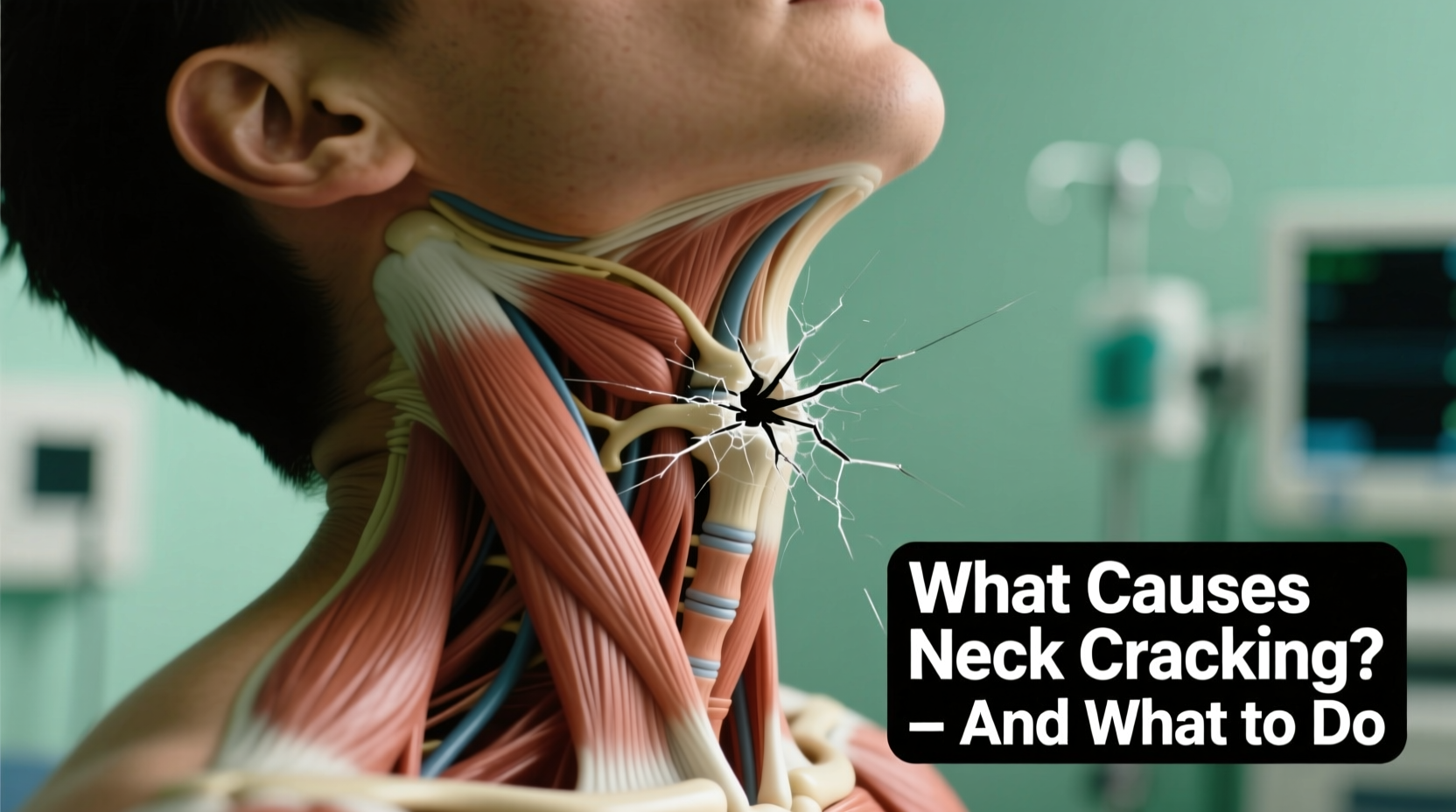That familiar popping or grinding sensation in your neck when you turn your head isn’t uncommon—but it can be unsettling. For many, the sound is harmless. For others, it may signal underlying tension, joint wear, or posture-related strain. Understanding the mechanics behind neck crackling helps separate normal joint behavior from signs that warrant attention. This article explores the science of crepitus, evaluates potential risks, and offers practical steps to maintain cervical health.
What Causes Neck Crackling?

The technical term for joint noises like cracking, popping, or grinding is crepitus. In the neck, this phenomenon typically occurs in the facet joints—small stabilizing joints between vertebrae—or within the surrounding soft tissues. Several mechanisms explain the sounds:
- Cavitation: When a joint is stretched quickly (as in turning the head), pressure changes cause dissolved gases in synovial fluid to form bubbles that collapse with an audible pop. This is the same process behind knuckle cracking.
- Soft Tissue Friction: Tight muscles, tendons, or ligaments may snap over bony prominences during movement, creating a clicking or rubbing noise.
- Joint Degeneration: Over time, cartilage wears down due to age or repetitive stress. As surfaces become rougher, they may produce a grinding or grating sensation known as crepitus, particularly common in osteoarthritis.
- Postural Strain: Prolonged forward head posture—common among desk workers—increases mechanical load on cervical joints, accelerating wear and altering joint dynamics.
“Crepitus without pain is usually benign. But if it’s accompanied by stiffness, weakness, or radiating discomfort, it may reflect joint dysfunction or nerve involvement.” — Dr. Lena Patel, Physical Medicine and Rehabilitation Specialist
When Is Neck Crackling a Concern?
Occasional, painless crackling during neck movement is generally not a medical issue. However, certain red flags suggest deeper problems requiring evaluation:
Symptoms that warrant medical assessment include:
- Persistent or worsening pain with movement
- Numbness, tingling, or weakness in arms or hands
- Dizziness or balance issues triggered by neck motion
- Reduced range of motion or locking sensations
- History of trauma (e.g., whiplash)
These could indicate conditions such as cervical spondylosis, herniated discs, or spinal stenosis. Imaging studies like X-rays or MRIs may be necessary for diagnosis.
Do’s and Don’ts for Managing Neck Joint Health
| Do | Don’t |
|---|---|
| Maintain neutral spine alignment while sitting and using devices | Crack your neck forcefully or repeatedly |
| Perform gentle range-of-motion exercises daily | Ignore persistent neck pain or neurological symptoms |
| Use ergonomic setups at workstations | Carry heavy loads unevenly (e.g., single-shoulder bags) |
| Apply heat to relax tight muscles before stretching | Sleep with your neck twisted or unsupported |
| Seek care from licensed professionals (chiropractors, physical therapists) | Self-adjust your cervical spine without training |
Step-by-Step Guide to Safer Neck Mobility
If neck crackling concerns you, follow this routine to improve joint function and reduce strain:
- Warm Up First: Apply a warm towel or heating pad to the neck for 5–10 minutes to increase blood flow and loosen connective tissue.
- Gentle Range-of-Motion Exercises: Slowly move your head through these motions—each held for 3 seconds, repeated 5 times:
- Chin to chest (flexion)
- Look up toward ceiling (extension)
- Ear toward shoulder (lateral flexion, both sides)
- Turn head side to side (rotation, both sides)
- Strengthen Supporting Muscles: Perform isometric exercises—press palm against forehead, then each side and back of head—resisting movement for 5 seconds each. Builds endurance without joint stress.
- Stretch Suboccipital Muscles: Sit upright, interlace fingers behind head, gently tuck chin while applying light pressure downward. Hold 20–30 seconds.
- Practice Postural Awareness: Set hourly reminders to check alignment: ears over shoulders, shoulders over hips.
A Real-Life Example: Office Worker Relief
Mark, a 38-year-old software developer, noticed increasing neck crackling and morning stiffness after years of hunching over dual monitors. The sound wasn’t painful, but he began experiencing headaches and shoulder tension. He consulted a physical therapist who identified forward head posture and weakened deep neck flexors.
Over eight weeks, Mark followed a structured program including ergonomic adjustments (raised monitor, external keyboard), daily mobility drills, and targeted strengthening. By week six, crackling decreased significantly, and his range of motion improved. Most importantly, his headaches subsided. His case illustrates how non-painful symptoms can still reflect biomechanical imbalance—and respond well to early intervention.
FAQ: Common Questions About Neck Crackling
Can cracking my neck cause arthritis?
No scientific evidence links occasional joint cavitation to arthritis. Osteoarthritis results from cumulative wear, aging, genetics, and injury—not from normal joint manipulation. However, habitual forceful self-adjustments may contribute to ligament laxity or joint irritation over time.
Should I see a chiropractor or physical therapist?
Both can help, but their approaches differ. Chiropractors often use spinal adjustments to restore joint motion, while physical therapists focus on movement correction, muscle retraining, and long-term stability. If pain or instability is present, starting with a physical therapist may offer more sustainable outcomes.
Why does only one side of my neck crack?
Asymmetry in muscle tension, joint alignment, or previous injuries can make one side more prone to noise. Uneven desk setups, sleeping positions, or dominant-side usage (e.g., cradling a phone) often contribute. Addressing postural imbalances usually reduces unilateral symptoms.
Conclusion: Listen to Your Body, Not Just the Sound
Neck crackling is rarely dangerous, but it shouldn’t be ignored if patterns change or new symptoms arise. The human body communicates through sensation and sound—learning to interpret these signals empowers better self-care. Small daily habits like posture checks, mindful movement, and workstation optimization go far in preserving cervical health.
Instead of focusing solely on eliminating the noise, prioritize function, comfort, and prevention. If in doubt, consult a healthcare provider trained in musculoskeletal assessment. Your neck supports your head thousands of times a day; treating it with consistent respect pays dividends in long-term mobility and well-being.









 浙公网安备
33010002000092号
浙公网安备
33010002000092号 浙B2-20120091-4
浙B2-20120091-4
Comments
No comments yet. Why don't you start the discussion?